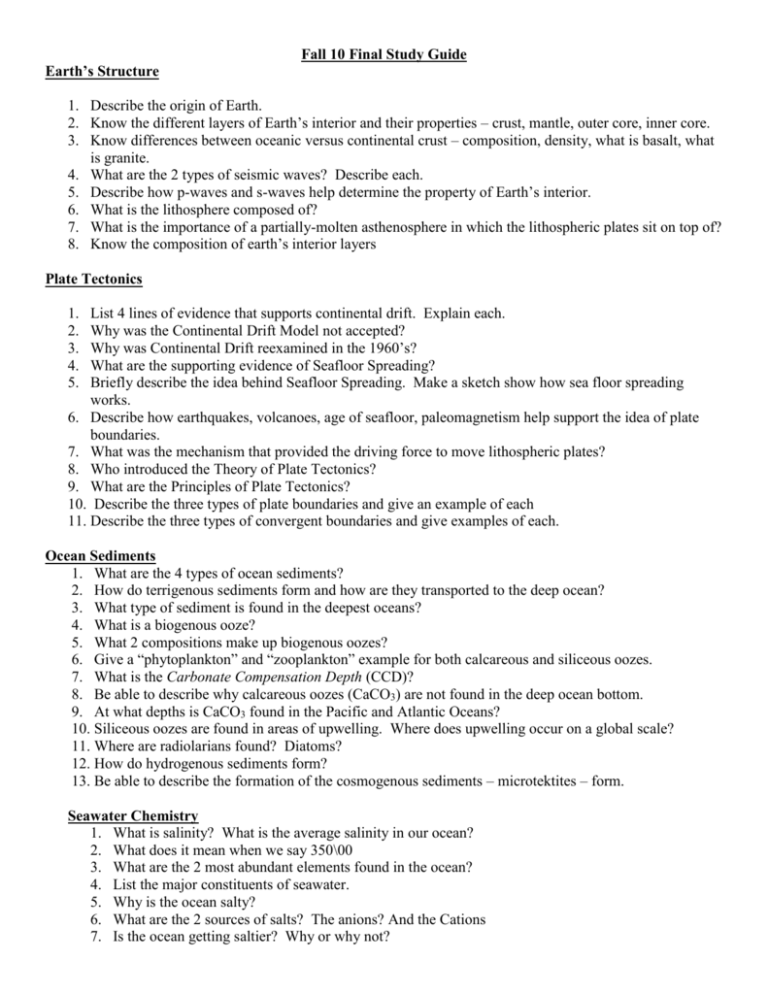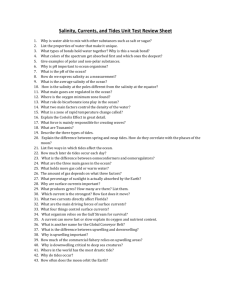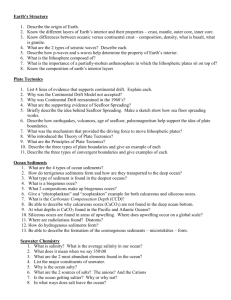Winter 08 Final Study Guide
advertisement

Fall 10 Final Study Guide Earth’s Structure 1. Describe the origin of Earth. 2. Know the different layers of Earth’s interior and their properties – crust, mantle, outer core, inner core. 3. Know differences between oceanic versus continental crust – composition, density, what is basalt, what is granite. 4. What are the 2 types of seismic waves? Describe each. 5. Describe how p-waves and s-waves help determine the property of Earth’s interior. 6. What is the lithosphere composed of? 7. What is the importance of a partially-molten asthenosphere in which the lithospheric plates sit on top of? 8. Know the composition of earth’s interior layers Plate Tectonics 1. 2. 3. 4. 5. List 4 lines of evidence that supports continental drift. Explain each. Why was the Continental Drift Model not accepted? Why was Continental Drift reexamined in the 1960’s? What are the supporting evidence of Seafloor Spreading? Briefly describe the idea behind Seafloor Spreading. Make a sketch show how sea floor spreading works. 6. Describe how earthquakes, volcanoes, age of seafloor, paleomagnetism help support the idea of plate boundaries. 7. What was the mechanism that provided the driving force to move lithospheric plates? 8. Who introduced the Theory of Plate Tectonics? 9. What are the Principles of Plate Tectonics? 10. Describe the three types of plate boundaries and give an example of each 11. Describe the three types of convergent boundaries and give examples of each. Ocean Sediments 1. What are the 4 types of ocean sediments? 2. How do terrigenous sediments form and how are they transported to the deep ocean? 3. What type of sediment is found in the deepest oceans? 4. What is a biogenous ooze? 5. What 2 compositions make up biogenous oozes? 6. Give a “phytoplankton” and “zooplankton” example for both calcareous and siliceous oozes. 7. What is the Carbonate Compensation Depth (CCD)? 8. Be able to describe why calcareous oozes (CaCO3) are not found in the deep ocean bottom. 9. At what depths is CaCO3 found in the Pacific and Atlantic Oceans? 10. Siliceous oozes are found in areas of upwelling. Where does upwelling occur on a global scale? 11. Where are radiolarians found? Diatoms? 12. How do hydrogenous sediments form? 13. Be able to describe the formation of the cosmogenous sediments – microtektites – form. Seawater Chemistry 1. What is salinity? What is the average salinity in our ocean? 2. What does it mean when we say 350\00 3. What are the 2 most abundant elements found in the ocean? 4. List the major constituents of seawater. 5. Why is the ocean salty? 6. What are the 2 sources of salts? The anions? And the Cations 7. Is the ocean getting saltier? Why or why not? 8. In what ways does salt leave the ocean? 9. What does the Principle of Constant Proportions state? How does this help us determine the amount of salt present? 10. What are 2 ways of determining salinity? 11. Be able to calculate salinity and chlorinity using formula. 12. What factors affect salinity? 13. What does Residence Time mean? 14. Why are chlorine and sodium the most abundant elements in the ocean? In other words why do they long residence times. 15. What are some of the effects of salinity? 16. List 3 ways to get fresh H2O from salt H2O. Be able to explain each. 17. What are the major gases in seawater? 18. Why is Oxygen (O2) abundant at the surface of the ocean? 19. Between 200 m – 1,000 m depth, O2 is decreasing and CO2 is increasing. Give 2 reasons? 20. At depths greater than 1,000 m O2 increases slightly. Explain how this happens. 21. How does CO2 control acidity? 22. What contributes to the increase of CO2 with depth? 23. Explain how CO2 acts a carbonate buffering system. Dissolved Gases 24. What are some of the effects of salinity? 25. List 3 ways to get fresh H2O from salt H2O. Be able to explain each. 26. What are the major gases in seawater? 27. Why is Oxygen (O2) abundant at the surface of the ocean? 28. Between 200 m – 1,000 m depth, O2 is decreasing and CO2 is increasing. Give 2 reasons? 29. At depths greater than 1,000 m O2 increases slightly. Explain how this happens. 30. How does CO2 control acidity? 31. What contributes to the increase of CO2 with depth? 32. Explain how CO2 acts a carbonate buffering system. 33. Describe the gas cycle. 34. What are the major nutrients found in ocean water? . Surface Water Currents (Wind-driven) 1. When winds blow, how much are surface waters deflected? What is the net water movement when you take all of the wind vectors into account? 2. Which way is water deflected in the northern hemisphere? Southern hemisphere? 3. Be able to determine whether coastal areas (West Coast or East Coast) experience upwelling or downwelling with northerly and/or southerly winds. 4. Know whether convergence (currents coming together) or divergence (currents moving apart) produces upwelling or downwelling. 5. What are gyres? 6. In the Pacific Ocean, where do you find warm ocean currents? Cold ocean currents? 7. Why are gyres displaced to the west? 8. What is the difference between “Western Intensification” and “Eastern Currents”? 9. Be able to list 5 factors that influence an El Nino Year. Beaches 1. What is a beach? 2. Know shoreline divisions. Littoral zone, wave action zones, sediment profile zones 3. Know beach types and give an example of each 4. What is the difference between a summer beach and winter beach? 5. Why does a beach grow in the summer and shrink in the winter 6. What is refraction? 7. What is a rip current? How is it formed? 8. Describe movement of longshore current in terms of “swash” and “backwash”. 9. What is longshore transport 10. What is deposition and what are some of its features? Erosion and its features? 11. What is a cliff, wave cut bench, and marine terrace? 12. How is a cliff formed? 13. Know some of human impacts and interventions.








